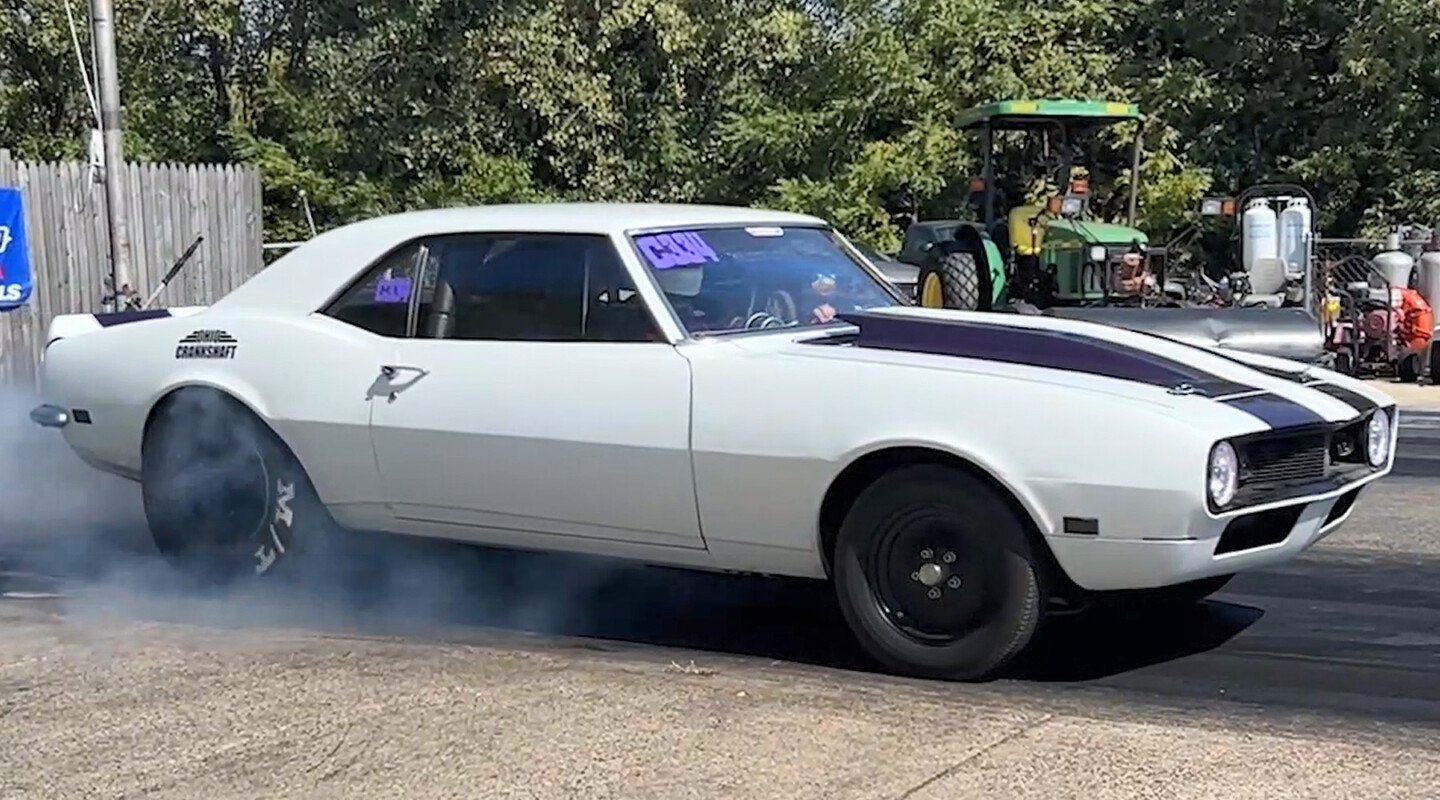Whether it will be a long winter’s nap for your race car or if you’re working on updates for the upcoming season, this downtime is an opportunity to place your rearend differential assembly under scrutiny.

The last pass of the season had us already planning the maintenance schedule on our Camaro for the next year. With our 800 horsepower combination, our 12-bolt rearend maintenance program will consist of a fluid inspection during mid-season and a full inspection of internals every winter.
We got recommendations from two experts: Jeff Anderson, Marketing Director with Moser Engineering, and J.C. Cascio, Director of Business Development at Strange Engineering, each of whom provided expert insight into checking over and preparing our rearend housing for another season of drag strip hits.
Maintenance Frequency
With the snow flying but a new season nearing, it’s time for a thorough “trust but verify” session inside our Camaro’s rearend. How often you examine your differential can vary with your horsepower versus weight ratio. We decided to perform a mid-season oil check and then, during the off-season, dig into inspecting all of the components and ensuring measurements and setup tolerances are proper.
With many varying levels of power output in drag racing, checking out the rearend anywhere from weekly, monthly, or once or twice a season is essentially up to you and your performance level.

Our new-to-us Camaro contains a GM 12-bolt truck rearend with top-shelf internals. A light inspection when purchased verified components, and we checked the gear oil for any problematic signs. Now, during the off-season, we’re going through the differential with a magnifying glass.
Too High Or Low Gear Oil Levels Can Cause Damage
One practice we learned long ago was to check the gear oil level before draining. Your checkup must be more diligent if the rearend is under- or over-filled. Unlike your engine or transmission, your rearend lubricant is not pressurized. An under-filled gear oil level may prevent oil from reaching critical lubrication points. Alternatively, overfilling can cause a “churning” effect, where aeration lessens the lubricating properties.
“Most drain plugs use a magnet to collect any shavings floating around in the rearend,” Cascio explains. “A quick look and the magnet can be your first alert if something bad happens in the rearend. Some people will drain the oil through a strainer to see if any debris is present. If everything looks okay, the oil can be reused.”
Gear Oil Inspection For Fragments
Much like your engine or transmission, inspecting for debris in your rearend should always be on your routine and off-season inspection checklist. When we empty the gear oil, we have a dedicated drain pan only for draining racing engine, transmission, and gear oil. This pan is thoroughly cleaned and bagged between use.
In any high-horsepower drag race application, routine inspection is highly recommended. At one extreme, most big-horsepower teams will drain the oil and visually inspect the ring and pinion every couple of races. – J.C. Cascio, Strange Engineering
Anderson says, “If it is a competition rearend with multiple runs, look for fragments or possibly metallic residue. A deeper inspection is warranted if you see metal or a fine metallic sheen in the drained fluid.”
“If you install a new ring and pinion, a coating sometimes flakes off the gears during the initial runs,” Anderson adds. “A little more heat may be generated during break-in. It’s good to check the fluids after your first couple of outings before problems elevate.”
With a quick wipe-down of our dedicated drain pan, we can examine the gear oil without any previous debris. We also carefully scrubbed the entire outer housing to not drop anything into the gear oil we wanted to examine.
Physical Inspection of The Rearend
Varied rearend designs have the differential assemblies within a removable center section, or, like our 12-bolt, the differential assembly is part of the overall rearend housing. Either way, the differentials require the same basic inspections. Before removing the cover or the center section, we diligently cleaned the outer housing with high-detergent parts cleaner. No fragments from the outer housing should be allowed to fall into the drain pan and be confused for internal contaminants.
Next, you can perform the general gear oil drain and move the pan to your workbench for further inspection; this protects it from any other under-car debris.
What’s That Smell?
Consider your used gear oil color and smell before proceeding. As if gear oil doesn’t smell odd when fresh, it will stink if the oil has been overheated and needs replacement.
“If you detect a burning smell from the used oil, definitely change it,” recommends Cascio. “More importantly, something has overheated the gear oil, and a thorough inspection is paramount.”
One of the most common culprits in burnt gear oil is bearing problems. With many small roller elements, a damaged bearing is an efficient way to generate heat quickly. Whether it be the differential or axle bearings, uncommon forces from a separate problem, or worn bearings themselves, require a thorough rearend overhaul immediately.
Our girdle-style cover braces each main cap to help prevent bearing cap deflection. We loosened the torque specs of the brace studs before opening the cover and drain the gear oil. We then inspect the gear oil for any debris indicating excessive wear.
Anderson adds his thoughts on gear oil heat. “Heat that makes the center section hot to the touch or retains heat in the overall rearend housing could signal issues. The burnt rear gear fluid smells similar to a transmission exposed to above-normal operating temps.
Check Overall Fit And Tolerance
For the first of the litmus tests, visually look at the ring gear and pinion teeth for raw indicators of problems. Cascio immediately jumps into proper inspecting backlash and more with good measuring tools to the thousandths of an inch.
“Checking the overall pinion depth, pinion bearing preload, backlash, and carrier bearing preload can spot problems early on,” Cascio says. “As a ring and pinion breaks in, the backlash can open up and the preload decrease.”
Center sections are removable from the housing in the 9-inch Ford rearend. Our GM 12-bolt and this Ford 8.8-inch rear end are designed with the differential unit as part of the overall housing.
“Without documents of the initial set-up, it would be hard to determine how much it has changed,” adds Cascio. “If you suspect tolerance problems, such as backlash, contact the ring and pinion manufacturer for their acceptable tolerances.”
We needed info on the Camaro differential, so we looked online at the ring and pinion brand. We found the installation instructions that noted backlash tolerances between 0.010-and 0.014-inch. For our setup, we checked various tolerances with the dial indicator. Our backlash indicated 0.013 inches of movement, which is between the 0.010- and 0.014-inch tolerances.
A tell-tale indicator of changes since your initial differential assembly is the re-inspection of your ring and pinion contact pattern. Use the gear marking compound and see if the patterns match the proper setup patterns. Rotate the pinion gear by hand while providing resistance against the ring gear rotation with your other hand. Do this process in both directions, illustrating drive and coast patterns on each side of the teeth.
If those backlash numbers appear large, it makes sense when you factor in the tolerance that tightens once the gears are at operating temperature.
Strange Engineering’s Cascio says, “For in-house evaluation, we will take a close look at the root of each tooth to see if there are any cracks present, check backlash, and preload.”
Differential bearings often can experience damage from bad tire shake or just from wear and tear over the lifetime of the spool and axles. – Jeff Anderson, Moser Engineering
The pattern on the marking compound is compared to the illustrations offered by your ring and pinion manufacturer. Example patterns indicate if the tooth mesh is too shallow or too deep. An imperfect mesh can weaken the tooth strength, create rear differential noise, or cause severe breakage.
Bearing Inspection
“You’re transmitting a lot of power to the ground; this carries the load through the bearing’s races,” says Moser Engineering’s Anderson. “This load continues to the bearings’ seats, then to the inside bore of the housing. The forces at play, especially with tire shake, are extremely high. Every time you check out your differential, it’s a good time to inspect the axle bearings.
All bearings should rotate freely with no binds and smoothly with zero looseness within the entire bearing assembly. Anything short of that with the bearing can and will cause damage to all other components.
Axle Inspection
Drag race axles endure a lot of twisting force that can result in axle twist or bends. Before axle removal, check for a very snug fit between the axle splines and your spool/differential. If the axle splines can bind when installed or removed, you may have axle bends or twisting in the axles.

You can see the fine white line on the axle shaft we added that helps us spot any axle twist in future inspections. The red arrows at the axle splines indicate where the splines end at our spool. Not only should you closely look over the general splines, but check for any twist in this area.
Also, there is an additional designed spline length beyond where the spool meets the spline. With the axles removed, you should see no twist in the splines or changes between where the spool contacts the axle splines and outside that point.
An old trick we learned is to gauge any overall axle twist by painting or scribing a straight line the length of each axle shaft. Then, you can visualize axle twisting in the future.
Never Take Your Rearend For Granted
Your drag car is a master of transferring power on the engine side of your drivetrain, and a slave at the rearend, where this power meets the pavement. Unlike street hot rods, big horsepower and open headers can cover up any audible whining or seat-of-the-pants symptoms. If you dutifully maintain your engine and transmission, plus treat your rearend with the same mechanical inspections, you can alleviate an angry differential by not ignoring them.












